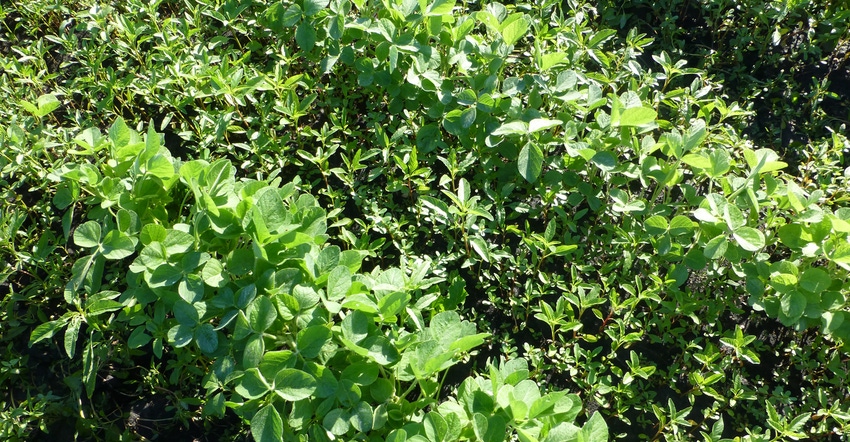March 21, 2019

The greatest motivational speech ever may have come from a tractor seat. “Screw this up, and you’ll end up with a hoe in your hands again!” Likely also one of the shortest motivational speeches ever, but Tom Osborne or Bear Bryant couldn’t have gotten a greater effort out of us.
We got the speech while we were strapped into the seats of what might as well have been the space shuttle to us, the technology was so far ahead of where we had been just a few days earlier.
Sitting on a steel beam running across the front of a tractor and getting paid to “shoot weeds” from above with a hand-held sprayer wand beat the heck out of “walking the beans” — whacking them on foot with a hoe.
Other key points from the boss included “The spray kills everything,” “Hit as many weeds as you can,” “as few beans as you can,” “Don’t spray each other” and “The spray is bright purple, so we can all see who’s screwing up.”
This took place years ago when we were teenagers. A couple of seasons on the bean buggy, and we learned a lot about pest management. Turns out the spray didn’t “kill everything,” so later in the season we still had some weedy spots to walk. Nozzle selection, distance from and size of target, and wind speed were just a few of the variables that determined where and how much purple spray ended up on weeds vs. beans vs. each other. But hey, when the incentive for figuring it out quickly is not spending as much time hiking with a hoe, learning seems easier.
Lessons learned about IPM, PRM
Those first lessons in Integrated Pest Management (IPM) and Pest Resistance Management (PRM) stuck with me because the boss was a great guy who kept things fun and simple, knowing the limited attention span of high school boys. Whatever IPM we were doing seemed like it worked since the boss had fairly clean fields, we spent less time on the business end of a hoe, and we were handed cash for our work.
Integrated Pest Management and Pest Resistance Management: What are they and do they really matter? I won’t get all scientific. You have a solid idea of what it is since you’ve been doing it for a living for years. Definitions vary, but generally:
Integrated Pest Management. IPM is a process consisting of the balanced use of cultural, biological and chemical procedures that are environmentally compatible, economically feasible and socially acceptable to reduce pest populations to tolerable levels.
Integrated means many strategies are used to avoid or solve a pest problem, like combining higher plant populations or narrow rows with herbicide programs to limit weed competition. Pests are disease, weeds, bugs, politicians. Management is the process of making decisions in a systematic way to keep pests from reaching “intolerable levels.”
Pest Resistance Management. PRM is the effort to delay pests from developing resistance. Pest resistance will impact yields, increase cost of production and limit farmers’ future options to manage pests.
There are other definitions for PRM, but one thing most of them have in common are concepts relating to “delaying” or “limiting” the development of resistance. Mother Nature has found ways to work around or kick the tar out of a lot of various control measures to date, so “stopping” resistance is probably not possible in the foreseeable future.
Concepts’ importance
We all have a pretty good idea what various answers to this question are, and the definitions of IPM and PRM lay it out, too. If we don’t collectively implement and continually improve our IPM and PRM programs, yields drop, cost of production rises, and pest management options become more limited. So yes, we know why the concepts are important, yet we keep fighting a growing number of resistant pests. In other words, “we” aren’t doing a good enough job.
Oh man, that probably got the blood boiling — but hold on. “We” means scientists (industry, university, wherever), industry reps and agronomists, consumers, farmers, EPA lawyers, you name it. We’re collectively guilty of dropping the ball on ensuring that IPM and PRM are developed and carried out effectively.
Clearly, it isn’t that we all said, “The heck with it” and didn’t implement IPM and PRM on purpose. In many cases there were mistakes, miscommunication or some other problem somewhere up or down the information chain that led to pest resistance. We don’t need or have time to point fingers; we all must step our game up and do better — from cutting-edge science all the way through to the consumer.
Mother Nature hard to beat
Let’s look at a couple types of pesticides — insecticides and herbicides — for examples of how quickly and creatively nature has adapted to some of them:
Insecticide resistance. It can be said the chemical age kicked off with the introduction of synthetic organic insecticides in the early 1940s (think DDT). Resistance to DDT was confirmed in houseflies by 1947. New insecticides came out. And with every new insecticide introduced, cases of resistance appeared some two to 20 years after their introduction in a number of key pest species. Mother Nature has won every time.
Weed resistance. This has been beating us over the head for decades. We have weeds today in our fields resistant to a lot of herbicides, and they have cost a lot of time and money. So far, we’ve risen to the challenge and found a way to pound weeds back into submission for a time. But the cycle is evolving, and the discovery of waterhemp resistant to Group 15 herbicides in at least two Illinois counties is disappointing news.
The Group 15s are some of the most resilient and rock-solid products we have, used heavily in both corn and beans. Worldwide, there are only a handful of cases of grass weeds resistant to the 15s and only one in the U.S. These waterhemp populations are the first broadleaf weed in the world resistant to the Group 15s. This might not come as a big surprise. The two documented G15-resistant waterhemp populations in Illinois were resistant to other herbicides as well, with some now resistant to six sites of action.
Group 4 herbicides have been pretty solid for us over the years, so 2,4-D and dicamba-resistant soybean systems are viewed as an important tool in weed IPM by many. If we aren’t careful though, the ride could be short. Waterhemp resistant to 2,4-D has been found in Illinois, Missouri and Nebraska, so the experts tell us it is most likely present somewhere in Iowa. The Nebraska population demonstrated a low level of cross-resistance to dicamba.
Mother Nature knows how to stack and manipulate genes rather well — maybe better than we do.
We can beat resistance
Mother Nature has knocked around a lot of our good IPM strategies and just demolished us when our IPM work was lacking. On the flip side, we keep bouncing back and finding ways to keep our fields in pretty good shape on a consistent basis.
Yes, there are a lot of resistant pests out there, including the scary sounding five- and six-way resistant waterhemp. There have been some tough-looking fields from weed escapes; but so far, they are outnumbered by the amount of clean fields in most growing seasons. We’ll keep improving and evolving to try to keep ahead of the pests because it is our livelihood.
I’ve seen farmers and service providers broaden their IPM and PRM practices significantly in recent years — being more strategic with application rates, timing and product selection in herbicide programs over the last few years. Others are “implementing” additional “pest management” tactics (yes, one last plug for IPM) along with their herbicide programs. They mention strategies like narrow rows, cover crops and GIS guided cultivation, and I’m probably missing a few others. Last summer, I even saw people walking beans, so that lost art may make a comeback as part of our strategies in some instances.
The bottom line is that spraying the right rates at perfect times alone won’t keep us ahead of the pests. Narrow rows and cover crops alone won’t keep us ahead of the pests. New chemicals and technology alone won’t do it. GIS cultivation or solid seeding or any other strategy alone won’t do it. But if we integrate various strategies, we’ll have a much better shot at achieving consistent long-term success.
Just for fun, I’ll leave you with some inspirational words from a farmer I worked for years ago: “Screw this up, and you’ll end up with a hoe in your hands again!” With that in mind, here is a great place to build on your knowledge base at ipm.iastate.edu.
Thanks for reading, and have a safe and successful 2019 crop season!
McGrath is the research and Extension coordinator for the Iowa Soybean Research Center at ISU. Email mailto:[email protected].
About the Author(s)
You May Also Like






